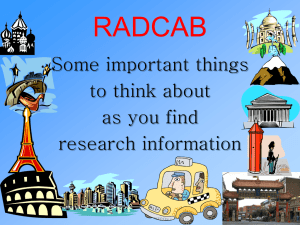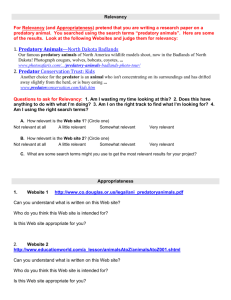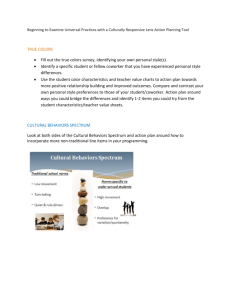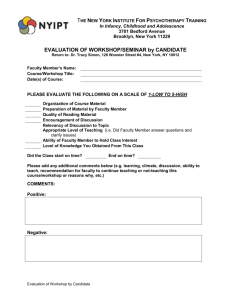FLINT-Ulieru-Final - theimpactinstitute.org
advertisement
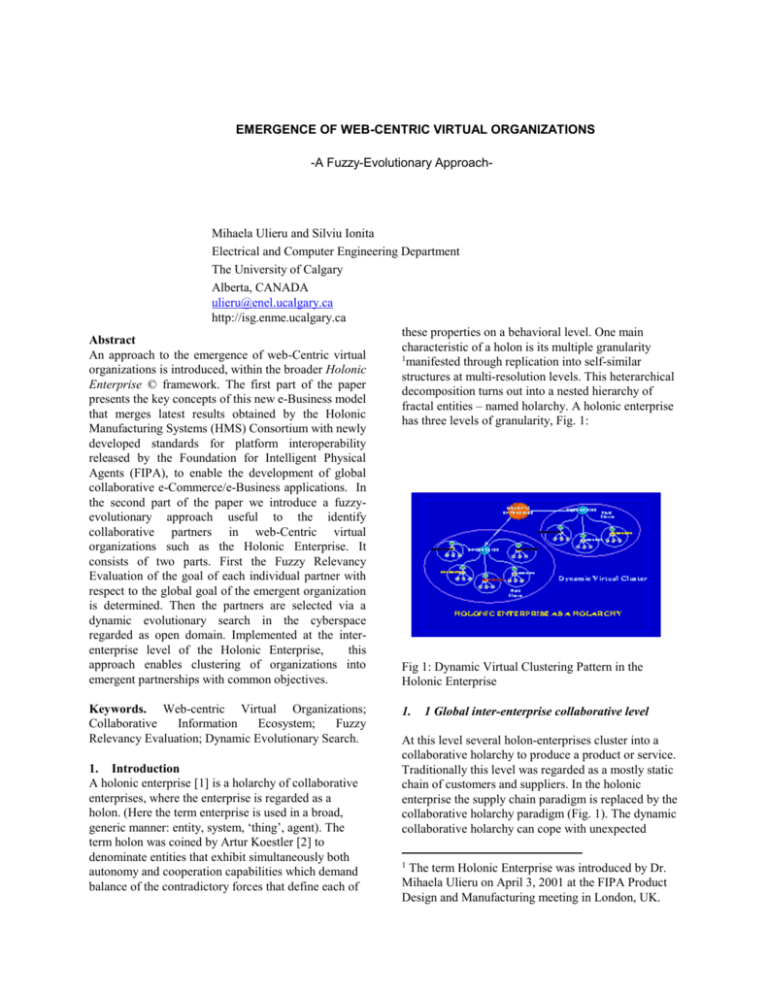
EMERGENCE OF WEB-CENTRIC VIRTUAL ORGANIZATIONS -A Fuzzy-Evolutionary Approach- Mihaela Ulieru and Silviu Ionita Electrical and Computer Engineering Department The University of Calgary Alberta, CANADA ulieru@enel.ucalgary.ca http://isg.enme.ucalgary.ca these properties on a behavioral level. One main Abstract characteristic of a holon is its multiple granularity An approach to the emergence of web-Centric virtual 1 manifested through replication into self-similar organizations is introduced, within the broader Holonic structures at multi-resolution levels. This heterarchical Enterprise © framework. The first part of the paper decomposition turns out into a nested hierarchy of presents the key concepts of this new e-Business model fractal entities – named holarchy. A holonic enterprise that merges latest results obtained by the Holonic has three levels of granularity, Fig. 1: Manufacturing Systems (HMS) Consortium with newly developed standards for platform interoperability released by the Foundation for Intelligent Physical Agents (FIPA), to enable the development of global collaborative e-Commerce/e-Business applications. In the second part of the paper we introduce a fuzzyevolutionary approach useful to the identify collaborative partners in web-Centric virtual organizations such as the Holonic Enterprise. It consists of two parts. First the Fuzzy Relevancy Evaluation of the goal of each individual partner with respect to the global goal of the emergent organization is determined. Then the partners are selected via a dynamic evolutionary search in the cyberspace regarded as open domain. Implemented at the interenterprise level of the Holonic Enterprise, this approach enables clustering of organizations into Fig 1: Dynamic Virtual Clustering Pattern in the emergent partnerships with common objectives. Holonic Enterprise Keywords. Web-centric Virtual Organizations; Collaborative Information Ecosystem; Fuzzy Relevancy Evaluation; Dynamic Evolutionary Search. 1. Introduction A holonic enterprise [1] is a holarchy of collaborative enterprises, where the enterprise is regarded as a holon. (Here the term enterprise is used in a broad, generic manner: entity, system, ‘thing’, agent). The term holon was coined by Artur Koestler [2] to denominate entities that exhibit simultaneously both autonomy and cooperation capabilities which demand balance of the contradictory forces that define each of 1. 1 Global inter-enterprise collaborative level At this level several holon-enterprises cluster into a collaborative holarchy to produce a product or service. Traditionally this level was regarded as a mostly static chain of customers and suppliers. In the holonic enterprise the supply chain paradigm is replaced by the collaborative holarchy paradigm (Fig. 1). The dynamic collaborative holarchy can cope with unexpected 1 The term Holonic Enterprise was introduced by Dr. Mihaela Ulieru on April 3, 2001 at the FIPA Product Design and Manufacturing meeting in London, UK. disturbances through on-line re-configuration of the open system it represents. It provides on-line order distribution across the available partners as well as deployment mechanisms that ensure real-time order error reporting and on-demand order tracking. Task Decomposition Pattern Leads to using Mediator Design Pattern Creates virtual clustering when mediators use Virtual Clustering Pattern is used to add clone to virtual cluster Partial Cloning Pattern 1. 2 Intra-enterprise level Once each enterprise has undertaken responsibility for the assigned part of the work, it has to organize in turn its own internal resources to deliver on time. Planning and dynamic scheduling of resources at this level enable functional reconfiguration and flexibility via (re)selecting functional units, (re)assigning their locations, and (re)defining their interconnections. Reconfiguration of schedules to cope with new orders or unexpected disturbances (e.g. when a machine breaks) is enabled through re-clustering of the agents representing the actual resources of the enterprise. The main criteria for resource (re)allocation when (re)configuring the schedules are related to cost minimization achieved via multi-criteria optimization. 1. 3 Machine (physical agent) level This level is concerned with the distributed control of the physical machines that actually perform the work. To enable agile manufacturing through the deployment of self-reconfiguring control elements, each machine is cloned as an agent that abstracts those parameters needed for the configuration of the holonic control system managing the distributed production. 2. is used in creating a clone Prototyping Pattern Metamorphic Architecture Pattern Fig 2: Pattern Interaction within the metamorphic Architecture Metamorphic Architecture Pattern. This pattern works by synergetic integration of two other patterns: Dynamic Virtual Clustering configured to minimize cost and enabling for flexible, reconfigurable structures. At all levels of the holonic enterprise, task propagation occurs by a process of virtual cluster (or holarchy) formation. This pattern is facilitated by the general layered architecture of the holonic enterprise. Mediator Agent Pattern supporting the decisionmaking process that creates and (re)-configures the dynamic virtual clusters of collaborative entities. Partial Cloning Pattern. This pattern defines which of the enterprise’s characteristics (attributes and functionality) we need to abstract into agents at each level when modeling the holonic enterprise as a collaborative multi-agent system. Patterns of Holonic Collaboration The common mechanisms that characterize the collaborative information ecosystem created by the three levels of a holonic enterprise follow the following design patterns for adaptive multi-agent systems [3] (Fig. 2). The overall architecture of the Holonic Enterprise builds on the Metamorphic Architecture Pattern that replicates at all levels. In the sequel we propose a fuzzy-evolutionary approach that implemented within the mediator can optimize the dynamic virtual clustering process. 3. A Fuzzy Measure for Collaborative Partnering In this Subsection we introduce a fuzzy approach capable to capture relevancy of the individual goals of possible collaborative partners with respect to the global goal of the emergent organization, by appropriate modeling of the linguistic ambiguity. The search problem can be defined as a mapping of the search indexes (term frequency occurrence; position of the key term in the document and its linkage to other documents, etc) onto the relevancy measure r, Fig. 3 [5]. The search criteria are fixed and predefined according to user interests in the beginning of the search process. The relevancy evaluation results in a ranked list with the best-fit documents on top. The main idea here is to express the informational relevancy as a multivariable function: relevancy r (i1 , i 2 ,..., i n ) (1) where i1 , i 2 ,...i n are the search indexes used in the informational evaluation of the document. To optimize the search means to optimize the function r (1). It is not trivial to find an adequate expression for the relevancy function to be able to get its value for each particular document. Indexing Users Searching criteria Space of indexes i1 i2 . : in MODEL Relevancy ? r Fig. 3: Search Model By establishing the fuzzy model [4] connecting the fuzzy sets of indexes and the weighted relevancy of the documents found a search strategy is determined as an aggregate of all indexes. The strategy for indexes aggregation is, Fig.3: IF (i1 =<label> AND i2 =<label> AND . . . i7 =<label> ) THEN r =<label> process in a set of documents is analogous to the genetic selection of the most relevant ones in a population of documents. The genetic operators pm – mutation probability and pc – crossover probability in the probabilistic model that generates the new structures (genotypes) in the evolutionary processes can be defined for a population of documents in a dynamic, open search domain. In this way the most relevant documents with respect to the search indexes will be naturally selected as ‘best’ through the evolutionary process. The intrinsic property of global optimizer that the evolutionary process exhibits leads naturally to increase the gradient of the relevancy (1), Fig. 3 as it searches for the ‘best’ solution in each ‘generation’ of documents. This analogy is detailed on a complex case study in [5]. Now both steps of the search (the relevancy evaluation and the ranking of documents) can be done concurrently, Fig. 4 as the search domain can expand continuously and new documents can enter it at each iteration/’generation’. This gives the search a dynamic context. To achieve this we shall use the general property of Genetic Algorithms (GAs) to find the global optimum as the best search results [6]. We propose a model based on the following assumptions: The search is an evolutionary process in the space of indexes aiming to optimize the document relevancy as an objective function. New docs from web 4. An Evolutionary Dynamic Search Strategy for Finding Collaborators in Cyberspace Besides refining the search by accommodating the intrinsic ambiguity of natural language, the fuzzy model method has no other advantage as search strategy relatively to the existing search engines which sort the information by searching a predefined, static domain In this subsection we introduce an iterative, incremental search strategy that expands the search domain over time. For this we use the property of global optimizer inherent in genetic algorithms. Our construction is based on the observation that the search The most relevant on top The worst out Fig. 4: The search process The search domain is open (expanding after each search) but relevancy estimation and documents ranking are made on a partial domain (a predefined population) each time. At each iteration (i.e. new domain expansion) the documents are reached according to their location in the current partial search domain. The lowest relevant documents will be replaced with newfound ones in the extended domain. The final result is obtained when the entire defined population contains the most relevant documents. The results reflect always the best partial relevancy ranking and depend on when the user stops the continuous incremental spiral search process in the practically infinite cyberspace. The user has at each moment the global optimum with respect to the number of iterative partial searches that are driven by the local optimal relevancy ranking on each partial domain. With these assumptions the search problem could be described as follows: (a): Inside a finite data space search for the most relevant P documents according to a predefined goal. The group of found documents represents the initial population consisting of P members. They are the phenotype. Any evaluated document has a numerical index evaluating its relevancy with respect to the search context. (b): As the search space expands the members of P are changing continuously, those members with low indexes being eliminated and by this making room for new members found to have higher relevancy indexes. (c): For each document/member its set of indexes constitutes the genotype. They are numeric (words repetition rate, number of words) and represented as binary strings. Theoretically the index term frequency is defined e.g. on the interval 0% to 100% that means in binary from 000000 to 1100100, therefore seven bits maximum. Concatenating the binary domains for all seven indexes we need 49 bits; therefore in this case the chromosome will have 49 bits length. (d) The initial population evolves by reproduction based on the two major genetic operators: mutation and crossover which are probabilistic parameters pm and pc. Each chromosome of the population (i.e. relevancy index) will be randomly affected. The isomorphic consideration of genetic operators in the context of information search process interprets mutation and crossover operators as modeling the probability of finding keywords inside the partial domain considered at each iteration. (e) The population's evolution generated from the previous search is controlled by the selection mechanism [6]. This is possible by defining a certain evaluation function as a selection criterion. In essence this function is the model "?" in Fig. 3 reflecting the relevancy of the document. The essence of this evolutionary search process stems from the recursive modification of the chromosomes of the concatenated indexes in each generation while monitoring the evaluation function. With each iteration all members of the current generation are compared with each other. The best results are placed on the top and the worst are replaced with the new members. The subsequent iteration resumes this process on the partially renewed population (for details see [5]). The link between the evaluation function and the relevancy is made by the search query criterion. E.g. if we want to find the documents focused on a concept we must establish the values for each indexes as associate descriptors to our query. For example the query about "fuzzy semantics" could be done as: fuzzy semantics / i1 80%, i2 10,..., . An evaluation function based on the distances between the c * current indexes ik and the query's indexes ik is: Fk ikc ik* , k 1, 2 ,..., n (2) The optimum criterion about relevancy is determined at each step as min( Fk ) among all members of that generation. 5. Simulation Results 5.1. Fuzzy Relevancy Evaluation We will evaluate the fuzzy relevancy searching on N=100 documents using the following three search indexes [5]: Term frequency i nterm 100 ; where nterm 1 n total is the number of times the searched term was matched exactly in the text. The frequency of occurrence of different forms for n the term i tdf 100 ; where ntdf is the 5 n total number of different forms of term found. n The synonyms’ frequency i syn 100 ; 6 n total where nsyn is the number of synonyms of term found. The simulation2 of this model was made considering random values for parameters nterm, ntdf, nsyn. The sets of indexes for the first ten of the N documents are given in Table 1. The last column contains the relevancy of the document evaluated by the fuzzy model. Table 1. The partial numerical results of fuzzy model of relevancy Doc . No. 1 2 3 4 5 6 7 8 8 10 Index 1 i1 Index 2 i5 Index 3 i6 Relevancy r 8.3394 0.0234 7.8670 1.7032 3.8987 14.019 8 6.2830 0.1740 5.7781 10.231 7 0.8656 3.1849 10.479 6 5.0108 5.3589 10.921 4 12.568 9 14.502 1 2.1745 3.4055 13.015 1 8.5389 1.2014 6.5011 6.4499 0.2833 14.909 0 2.4127 6.2926 10.854 2 5.7751 2.2641 6.0416 3.5807 5.4230 9.1351 7.1046 5.9999 3.9381 5.0728 Fig.5. illustrates the different relevancy degrees according to the strategy of search for the whole set documents. 5.2. Evolutionary Search on a Dynamic Domain For the same case and the same kind of indexes 2 The Fuzzy toolbox of MatLab was used to run the model. Fig. 5: The non-ranked relevancy marks we now use a search query with specified goal as follows: i1* 10% , i2* 5% , i3* 3% (3) Thus inside a finite data space it searches for the most relevant N=100 documents according to the specified goal as above. In each generation the population of N documents receives randomly new members (documents). Their random nature can be assigned the genetic operators mutation and crossover. This simulation was made with pm=1% and pc=20%. We assumed the maximum domain of any index was 15%. The new members will have the current informational c indexes ik , k 1, 2, 3 . The selection of the best member of a generation (the most relevant document) is made with criteria: min i1c 10 , min i2c 5 , min i3c 3 . We ran this model by adapting a more general program for automatic location problem [7]. Fig. 6 shows the mean of the evaluation function for the three indexes of relevancy on successive generations. It is clear how they all converge towards the best generation i.e. the set of best documents matching the search criteria. Fig. 6. The mean values of search indexes convergence towards the targeted values 6. Conclusions In the context of a global, web-driven economy, searching for collaborative partners may be reduced to a search for relevant keywords in the web pages of different organizations. The search methods introduced in this paper endow the holonic enterprise [1] with a mechanism for clustering the best partners to solve a particular task. On one side the fuzzy relevancy of the individual goals of each candidate organization with respect to the overall goal of the collaborative cluster is evaluated. On the other side this is done as a continuous, evolutionary process expanding the search domain until an optimal organization emerges, capable to solve the problem in the most efficient manner. The evolutionary selection of the optimal partners in the collaborative cluster in an open, ever-expanding domain facilitates the natural evolution of the virtual organization towards an optimal holonic structure. References [1] [2] [3] [4] [5] [6] [7] Mihaela Ulieru, Scott Walker and Robert Brennan, “Holonic Enterprise as a Collaborative Information Ecosystem”, Proc. Workshop: Holons, Autonomous and Cooperative Agents for the Industry, Montreal, Canada, May 20, 2001 (AA 2001). Koestler, A. (1960), The Ghost in the Machine, Arcana Press, NY. Shu, Sudong and D.H. Norrie (1999) “Patterns for Adaptive Multi-Agent Systems in Intelligent Manufacturing”, Proc. of the 2nd International Workshop on Intelligent Manufacturing Systems (IMS’99), Leuven, Belgium, pp. 67-74, September 22-24, 1999. Bezdek, J. Fuzzy Models: What are they and why, Editorial, IEEE Transactions of Fuzzy Systems, Vol.1, 1/1993. Ionita, S., Ulieru, M. (2001) A FuzzyEvolutionary Approach to Dynamic Search on an Open Ever-Expanding Domain in the Cyberspace, IEEE Transactions on Fuzzy Systems, Special Issue: Data Mining and Knowledge Discovery, December 2001 (submitted). Michalenicz, Z. Genetic Algorithms + Data Structures = Evolution Programs, Springer Verlag, 1992. Ionita, S. Genetic Algorithms for Control Engineering Applications (in Romanian), ECIT-97, Pitesti, Romania, 21-22 Nov. 1997, p. 77-84.
